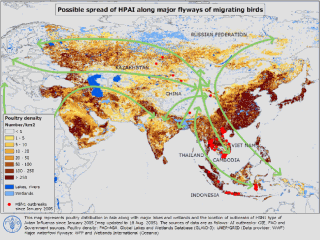| front |1 |2 |3 |4 |5 |6 |7 |8 |9 |10 |11 |12 |13 |14 |15 |16 |17 |18 |19 |20 |21 |22 |23 |24 |25 |26 |27 |28 |29 |30 |31|32 |33 |34 |35 |36 |37 |38 |39 |40 | 41 |42 |43 |44 |45 |46 |47 |review |
 |
The role of migratory birds in the spread of
highly pathogenic avian influenza (HPAI) is not fully understood. Wild waterfowl are considered the natural reservoir of all influenza A (including H5 & H7 subtypes) viruses. Considerable circumstantial evidence suggests that migratory birds can introduce low pathogenic H5 and H7 viruses to poultry flocks, which then mutate to the highly pathogenic form. In the past, highly pathogenic viruses have been isolated from migratory birds on very rare occasions involving a few birds, usually found dead within the flight range of a poultry outbreak. This finding long suggested that wild waterfowl are not agents for the onward transmission of these viruses. Recent events however make it likely that some migratory birds are now directly spreading the H5N1 virus in its highly pathogenic form. Further spread to new areas is expected. |